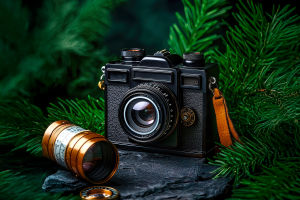You don't need an expensive DSLR to take stunning photos—your phone's camera can be just as powerful.
In fact, with a few tricks up your sleeve, you can elevate the quality of your mobile photography and achieve professional-looking results.
Whether you're snapping a beautiful landscape, capturing moments with friends, or shooting flat lay product photos for social media, these simple tips will help you make the most of your phone's camera.
1. Use Natural Light to Your Advantage
When it comes to photography, lighting can make or break your shot. While professional photographers invest in studio lights, you don't need all that to capture high-quality images with your phone. The best lighting source is always natural light.
Why it works: Natural light provides a soft, flattering effect, which helps to reduce harsh shadows and highlights, making your photos look more professional. Positioning your subject near a window or shooting outdoors during the golden hours (early morning or late afternoon) will give your photos a warm, inviting glow.
Avoid using your phone's flash unless absolutely necessary. The built-in flash often creates flat, unflattering photos. If shooting indoors without enough light, consider using reflectors (like a white sheet or poster board) to bounce the light back onto your subject, eliminating deep shadows and creating a more even lighting effect.
2. Get Comfortable with Manual Controls
Most modern smartphones come with some level of manual control over camera settings. Using these options can vastly improve the outcome of your shots, giving you more creative freedom.
Why it works: Adjusting manual settings like exposure, focus, ISO, and white balance allows you to control how the photo will turn out, instead of relying on your phone's automatic settings that may not always get it right.
For example, by lowering the exposure slightly, you can prevent overexposed highlights, ensuring that the details of your subject are sharp and clear. Similarly, adjusting the ISO will help avoid grainy images when shooting in low-light conditions. Familiarizing yourself with these settings gives you more control over how the light is captured, helping you achieve that professional touch.
If your phone's built-in camera app doesn't offer manual controls, you can always download third-party apps such as ProCamera or Manual Camera (Android), which provide a wider range of customizable settings.
3. Focus on Composition: The Rule of Thirds
Composition refers to how you arrange the elements in your frame. One of the easiest yet most effective compositional techniques is the rule of thirds.
Why it works: The rule of thirds involves dividing your frame into a 3x3 grid, with the subject placed at the intersection points or along the gridlines. This method creates a sense of balance, guiding the viewer's eyes naturally across the image without making it feel overly staged or cluttered.
To enable this on most smartphones, you can activate the grid lines in your camera settings. Once the grid is visible, position your subject along the lines or at the intersection points for a more dynamic and well-composed shot.
4. Master the Focus and Depth of Field
Smartphone cameras may not offer the depth of field you'd get with a DSLR, but you can still create the illusion of a shallow depth of field with a few tricks.
Why it works: A shallow depth of field helps isolate your subject from the background, making it appear more focused and creating that “blurred background” effect that we see in professional photos. This is perfect for portraits, food photography, or any image where you want to emphasize one particular subject.
To achieve this with your phone, tap on the screen to focus on the subject you want sharp. For additional background blur, try positioning your subject closer to the lens and ensuring the background is farther away. Some smartphones also have a "Portrait Mode" that automatically applies this effect, so it's worth experimenting with.
5. Avoid Zooming In
Smartphone cameras typically don't have the same optical zoom capabilities as professional cameras, and when you zoom in, you often lose image quality, leading to grainy and blurry photos.
Why it works: Rather than zooming, try to physically move closer to your subject. If you can't physically move, you can crop the image in post-production. Cropping won't impact the quality as much as zooming in while taking the shot, so it's better to frame your photo with a wider shot and adjust it later.
Using a zoom lens attachment for your smartphone is another way to achieve better zoom shots without sacrificing quality. These attachments are small, portable, and relatively inexpensive, providing a new level of detail without distortion.
6. Use Gridlines and Symmetry for Clean Shots
Symmetry can make for striking, attention-grabbing photos. Symmetrical scenes or subjects are naturally pleasing to the eye because they create balance. You can use your phone's gridlines (the 3x3 grid mentioned earlier) to help find and capture perfectly symmetrical shots.
Why it works: Whether it's a perfectly arranged set of dishes or a beautifully symmetrical building, symmetry creates harmony. It provides a sense of structure that's visually appealing, making your photo stand out.
When capturing a scene, line up your phone's camera with the symmetrical elements in your subject, ensuring that the main lines and shapes are aligned with the grid lines for a crisp, polished look.
7. Edit Wisely to Enhance, Not Overdo
Editing is where you can turn a good photo into a great one, but it's important not to overdo it. While smartphone apps like Snapseed or VSCO provide a wide range of filters and adjustment tools, subtlety is key.
Why it works: Over-editing can make your photo look artificial, which is not the goal. Instead, focus on enhancing the natural features of your image. Brighten the colors slightly, adjust the contrast for depth, and sharpen details to make your subject stand out.
A little goes a long way with editing. For example, if you're editing a portrait, you can smooth out skin tones and brighten eyes, but be sure not to erase the natural textures that make the photo look authentic. Similarly, if shooting landscapes, increase the saturation just enough to make the sky pop without making it look unrealistic.
Mastering smartphone photography doesn't require professional equipment—it's about understanding the power in your pocket and applying a few tricks to elevate your shots. By leveraging natural light, controlling focus, using compositional techniques, and carefully editing your photos, you'll be able to take images that rival those captured with high-end cameras. Next time you're out and about, test these tips and see how much better your mobile photos can be.


